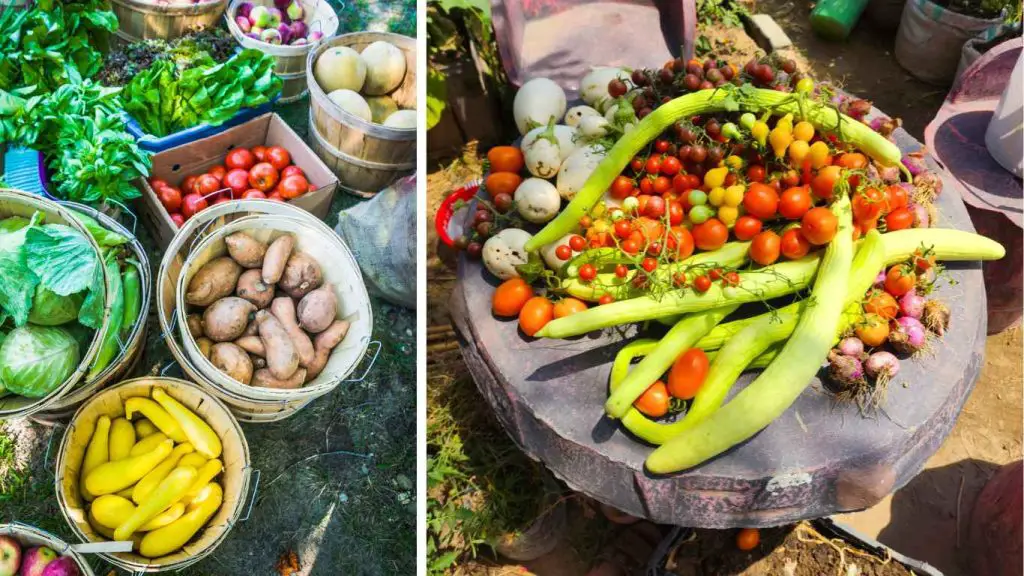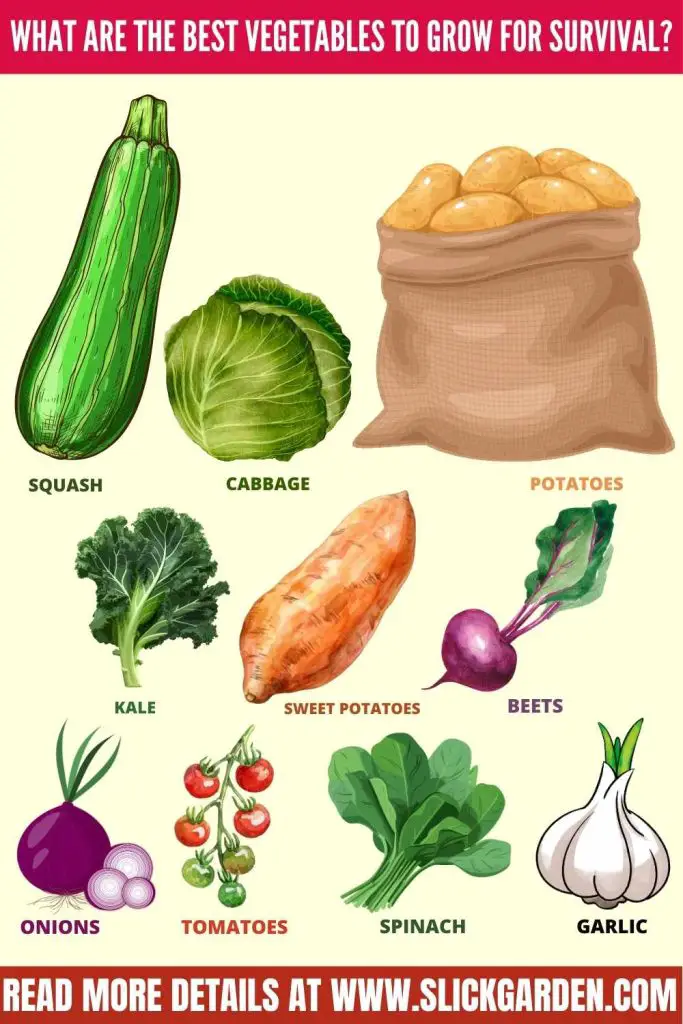You should be ready for a potential emergency because you don’t know what will happen in the future. Because you will never worry about storms and other emergencies when you can not access outside food if you always have food at home there is peace of mind.

A survival garden is not only for growing food for preparing for the worst but it will also supply vegetables for your kitchen and feed for your family.
This will be incredible when you use the absolute freshest ingredients in your favourite dish that is grown in your garden. If you have space to grow plants then you should try to grow fresh and healthy vegetables but keep in mind that plants need your time and care.
Planning Your Survival Garden Vegetables
When you grow vegetables in your garden you will get a fresh supply of vegetables for your kitchen. When selecting vegetables for growing in your garden, you must not select those items you don’t like because if you can’t eat the vegetables you grow in your survival garden, then there is no point in growing them.
Before planning and selecting vegetables for your survival garden you should consider the following points in your mind.
DO YOUR RESEARCH
If you are a beginner and don’t know anything about gardening then you should do some research about organic gardening, food preservation and seat saving.
You can also take classes from experts and take their advice so you can succeed in growing the best vegetables in the garden for survival.
CALORIES AND NUTRITION
A balanced diet contains colourful fruits and veggies so you will get the desired amount of vitamins, minerals and nutrients according to your body’s needs.
GEOGRAPHICAL LOCATION
The geographical location of your area is critical when you are selecting vegetable crops for your garden because all food items can’t grow in all areas.
For instance, sweet corn and melons like to grow in hot climates in the same way spinach and peas need cold environments. You must not select the vegetables that can’t grow in your area because there will be a higher chance of failure.
DETERMINE THE SIZE OF YOUR GARDEN
After completing your research about survival vegetables now you have to design only the garden. First, you should consider the size of the area you have.
Then you should think about the number of vegetables you can easily grow in your garden. If you have limited space then you must select those vegetables that are used in abundance and grow vertically. when you arrange your plants vertically they need less space.
Best Vegetables To Grow For Survival

When you are selecting vegetable crops for your garden then you should do some research about the calories you gain from different vegetables with nutrients.
You must choose the food variety that provides you with proteins and high starch. Following are some options of vegetables that can be grown in the survival garden.
1- SQUASH
It is a versatile vegetable plant that is easy to grow and produces a higher yield for you. You have to choose a sunny location in your survival garden for growing squash.
Make sure you have fertile and well-drained soil that has enough organic matter to nourish plants. The ideal temperature for growing squash is 65 degrees Fahrenheit.
If you are growing squash from seeds then you can plant 4 to 6 seeds directly in the ground or raised bed. You can also prepare seedlings and transplant them in their permanent location.
Related Article: How To Grow Zucchini Vertically In A Pot?
2- CABBAGE
You can’t deny the importance of nutrients that cabbage provides you. It has vitamins B6 and C with fibre that’s why you can grow it as a survival vegetable in your garden.
The interesting thing about cabbage is that you can use it raw. Your sandwiches, soups and casseroles become tasty after the addition of cabbage.
You can grow it in the cool season when the temperature is about 45 to 75 degrees Fahrenheit. The ideal time for planting is during the spring and fall.
Keep the soil moist by regular watering and make sure to man it by using organic matter such as compost or manure the perfect pH of soil for growing cabbage is 6.5 to 6.8.
3- POTATOES
Potatoes are included in those crops that help to survive in the time of famine. They are very nutritious as one cup of potatoes contains 116 calories.
It is a good source of potassium, Vitamin C, Vitamin B and valuable minerals. For growing this crop you need a sunny site and rich soil.
Before planting the potatoes, you must till the ground thoroughly because if the soil is compacted then it’s not easy for potato plants to spread their roots in the soil.
You can also easily store potatoes in bins for future use. The ideal temperature for keeping these beans is 45 to 60 degrees Fahrenheit. Potatoes can easily last up to 8 months. But you should examine them regularly in case they are sprouting or begin to spoil then use them.
Related Article: Simple Steps To Grow Potatoes In Bags In Greenhouse
4- KALE
You can easily keep dry kale for a couple of weeks in your fridge. But you should cover it in a damp paper towel to keep leaves hydrated and fresh.
Also, tolerate partial shade if you are living in a hot climate then a partially shaded area is perfect for growing them. In case you are living in a mild climate then you should not compromise on the light.
65 to 75 degrees Fahrenheit is a perfect temperature for growing kale. Rich and acidic soil is preferable for growing kale. You can add organic matter to make the soil nutritious for your survival garden. One thing you should take care of is that kale needs plenty of water.
5- SWEET POTATOES
There is a difference between sweet potato and regular potato. The sugar in boiled sweet potatoes is 14 times greater than in boiled regular potatoes.
For planting sweet potatoes that temperature must be 60 degrees Fahrenheit or 15 degrees Centigrade. To make your soil richer you can add liquid fertilizer that contains a high quantity of phosphorus.
After the application of fertilizer, you should water generously. The orange flesh is the fastest-growing variety of sweet potato. When you see the leaves are turning yellow then you can harvest sweet potatoes.
Generally, the harvesting time will be after 100 days from planting. If we talk about calories you will get 114 calories from the one cup of sweet potatoes. It contains vitamins, potassium, minerals and fibre that are needed by a healthy diet.
6- ONIONS
Onion is the basic ingredient in most dishes, so you must grow it. Because it is effortless to maintain this crop in your garden. You can harvest it from May to October.
You should select our sunny spot for growing onions in your garden. Keep your soil moist but avoid over watering because it leads to root rot.
This nutritious vegetable should not be harvested when the bulb is developing. You can store onions by freezing them or leaving them in the ground. For freezing you have to cut the onion into pieces now pop them in sealed bags and keep them in the freezer.
Related Article: How To Grow Onions From Onions?
7- TOMATOES
Another vegetable that must be grown in all vegetable gardens is tomato so why should you leave it out of the list of survival vegetables? It is a productive crop that produces 20 pounds of tomatoes over months.
You can add juicy tomatoes to your sources, soups and salads. There are over 10000 varieties of tomatoes found in the world. The yellow flowers of tomato plants turn to juicy fruit.
You should use tomato cages or staking to keep the tomato plants growing properly. When you install a support structure then tomato plants will get appropriate air circulation and harvesting becomes easier.
Related Articles:
- Can You Grow Tomatoes From Supermarket Tomatoes?
- How To Grow Tomatoes In A Vertical Garden?
- How To Grow Cherry Tomatoes From Slices
8- SPINACH
Spinach is a good source of vitamins and minerals and you can easily grow it as a survival vegetable. You can also store it by freezing or dehydrating.
The other way of storing it is by turning it into powder after crushing. Before growing spinach you should know that it is a cool-weather crop. The ideal time for growing spinach is in early spring or fall.
The perfect temperature is between 50 and 60 degrees Fahrenheit. In case you are living in a hot climate then you can choose a partially shaded area to prevent it from bolting.
Spinach is a heavy feeder that needs to be fertilized every 2 to 3 weeks. The application of fertilizer is essential for the healthy growth of spinach.
After 6 to 8 weeks you can easily harvest them but the roots are very delicate so you should be careful. It is better to remove the outer leaves every few weeks to encourage the growth of the inner leaves.
9- BEETS
This colorful vegetable likes to grow in the cool season. It can survive in the Frost and adjust even near freezing temperatures. The temperature should not exceed 75 degrees Fahrenheit or 24 degrees Centigrade for successive planting.
Before planting it, prepare the soil in your garden and make sure you choose a sunny spot. 6 hours of Sunlight with regular watering will allow the roots of the beads to grow to their proper size.
If you apply a layer of mulch then it will help to retain the moisture and eradicate the growth of weeds. There is no need for the application of such fertiliser that contains a high amount of nitrogen.
Because it will encourage the growth of greens and the size of the bulbs remain tiny beneath the soil. Most of the varieties are ready to harvest between 55 to 70 days.
10- GARLIC
The ideal soil that is used for growing garlic should be well-drained sandy and loamy. If you want the bulbs of garlic to grow freely then you must choose a sunny location and maintain the frequency level of water.
Keep the soil moist but avoid over-watering. It is better to grow garlic
near tomatoes, cabbage, and lettuce. When the cloves are totally developed then you should not leave them in the ground for a long time.
At this stage, you have to grab the stem close to the bulb and pull it gently. Do this task very carefully without damaging the garlic. Choose a cool place with good ventilation and low humidity for storing garlic.
Related Article: How To Grow Garlic Cloves Indoor
